More than half of men and women live with androgenetic alopecia. This term is used when talking about pattern baldness in men and women. Although both can face the problem of hair loss, there’s a significant difference in the age when hair becomes thinner, at what part of the scalp it occurs, and what other diseases can be connected to it. It is really important to know these differences because they can help with choosing a treatment that will be perfect for your case.
In this article, we have collected 5 differences between male and female alopecia.
- If we are talking about men, then in their case hair loss begins much earlier than in women, usually around 30 years of age. For women, this stage of life begins 10-15 years later, most often after menopause.
- Androgenetic alopecia does not occur on the whole scalp at the same time, which is why men will usually have a thinning hairline or a bald spot. For women, it is different. Usually it’s a spared hairline and thinning that goes from it.
You may also notice that those areas of the head that are balding may get sunburned just like any other parts of the body that are unprotected from the UV lights. In most cases women tend to hide their thinning hair in a ponytail.
3. There are different causes of alopecia, which can also be different for men and women. An important role in this question plays genetics. If you have the AR gene variation, your hair follicles are more sensitive to the testosterone-derived androgen called dihydrotestosterone (DHT). Higher levels of DHT will make your hair weaker which over time can lead to the stop of the hair growth.
There are also certain medical conditions for men and women that can, as the result, contribute to hair loss due to high levels of androgen. For women this disease can be polycystic ovary syndrome or PCOS. Additional symptoms of PCOS include: androgenetic alopecia, acne and even hirsutism (unwanted facial, chest and back hair).
As for men, prostate cancer can often be associated with hair loss. Studies have shown that the loss of hair on the top of the head in 25% of men is associated with prostate cancer. Also male baldness can be connected to cardiovascular diseases.
4. In recent decades the demand for testosterone replacement therapy among men has increased. The main purpose of replacement therapy is to eliminate the symptoms of low testosterone in men, which are: loss of sex drive, erectile dysfunction, loss of muscle mass, and mood swings.
One of possible side effects of this therapy is hair loss, acne, and oilier than usual skin. This is why it is very important while being on testosterone replacement therapy to control its level in the body, because the more testosterone, the more of it will be converted into DHT.
5. There are different treatments that are aimed to prevent hair loss, which also may differ for men and women. Minoxidil is the best option for both men and women for the treatment of androgenetic alopecia.
There are also oral options, such as Finasteride (Propecia). Due to possible side effects, this treatment is not suitable for women of reproductive age, but it can be really helpful for post-menopausal women.
In order to get the best kind of treatment for pattern baldness — consult a hair restoration expert.
You Might Also Like To Read
WHAT CAUSES BEARD HAIR LOSS (ALOPECIA BARBAE)?
While It Is Rather Uncommon Relative To Scalp Hair Loss, Beard Hair Loss (Alopecia Barbae) Is Something That Many People Suffer From.
HOW DOES A HAIR TRANSPLANT WORK?
Be Sure To Read This Before Your Hair Transplant Procedure
4 SURPRISING CAUSES OF HAIR LOSS
You May Not Be Aware Of These Surprising Causes Of Hair Loss


